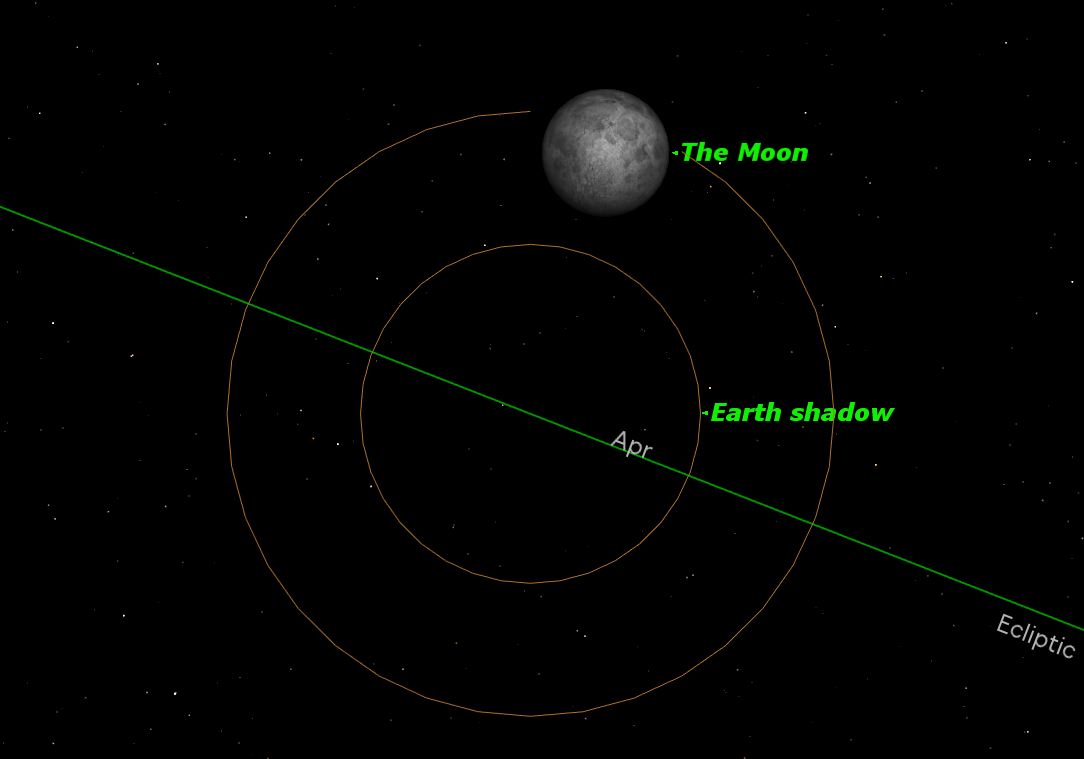
(Editor's Note: The Slooh Space Camera webcast of the penumbral eclipse has begun. Watch it live here: See Minor Lunar Eclipse in Slooh Webcast )
On Friday evening (Oct. 18), the moon will undergo an eclipse of minor importance — a "penumbral" lunar eclipse.
For nearly four hours on Friday, at least some part of the southern portion of the moon will be within Earth's pale penumbra, our planet's faint outer shadow. Penumbral lunar eclipses are rather subtle events that are usually difficult to detect unless at least 70 percent of the moon’s diameter shaded.
So the penumbra may be marginally detectable over the moon’s southernmost limb for just a short period centered on the time of the deepest phase/greatest eclipse (7:50 p.m. EDT, or 2350 GMT, Friday). At that moment, the penumbra will cover 76.5 percent of the lunar disk. [Shadowy Moon: Penumbral Lunar Eclipse Photos]
Those living in the eastern half of North America are well-placed to see this celestial event. But farther west, in the Mountain and Pacific time zones, the deepest phase of the eclipse occurs before the moon rises and during the late afternoon hours when the sun is still above the horizon, so no evidence, however slight, of this eclipse will be visible.
Meanwhile, the Indian subcontinent and the western half of China might notice some vestige of faint shading before the moon sets early on Saturday morning (Oct. 19). It is a delicate spectacle for eastern South America, all of Europe and Africa as well as western Asia. At mid-eclipse, the moon will appear in the zenith from Ouagadougou, the capital of the African nation of Burkina Faso.
Penumbral eclipse from the moon
Get the Space.com Newsletter
Breaking space news, the latest updates on rocket launches, skywatching events and more!
It might be easier to understand why the penumbral shadow of Earth is so faint by imagining being on the moon when Friday’s event takes place.
An astronaut on the moon during this time might see an eclipse of the sun, but it would all depend on our hypothetical moonwalker's lunar location. For example, no eclipse takes place from Aristarchus, a brilliant impact crater in the lunar northwest, as that part of the moon remains completely untouched by the penumbra.
That’s why the upper part of the full moon will appear to shine normally; no part of the Earth’s silhouette will appear to block any part of the sun from this portion of the moon.
By contrast, near the moon’s lower limb in the rugged southern highlands is the crater Clavius, the third-largest crater on the moon’s visible near side. From here, Earth will appear to cover about 70 percent of the sun’s diameter; consequently, the brilliant illumination of the surrounding lunar landscape will turn somewhat more somber.
This diminished effect of the glare of sunlight on the moon’s surface is precisely what those living in the eastern part of North America will be trying to detect during the deepest phase of the eclipse on Friday evening.
Can others see the shadow?
Here’s an experiment: At the peak of the eclipse (7:50 p.m. EDT; 6:50 p.m. CDT), bring a friend or family member outside with you who knows nothing about the eclipse and ask him or her to look at the moon and see if anything looks unusual.
About that time, even a casual observer — if he or she is looking hard enough — should be able to note a slight diminution of light corresponding to a "smudged" or "soiled" appearance of the moon’s lower limb.
Editor's note: If you snap an amazing picture Friday's penumbral lunar eclipse or any other night sky view that you'd like to share for a possible story or image gallery, send photos, comments and your name and location to managing editor Tariq Malik at spacephotos@space.com.
Joe Rao serves as an instructor and guest lecturer at New York's Hayden Planetarium. He writes about astronomy for Natural History magazine, the Farmer's Almanac and other publications, and he is also an on-camera meteorologist for News 12 Westchester, N.Y. Follow us @Spacedotcom, Facebook or Google+. Originally published on SPACE.com.
Join our Space Forums to keep talking space on the latest missions, night sky and more! And if you have a news tip, correction or comment, let us know at: community@space.com.

Joe Rao is Space.com's skywatching columnist, as well as a veteran meteorologist and eclipse chaser who also serves as an instructor and guest lecturer at New York's Hayden Planetarium. He writes about astronomy for Natural History magazine, Sky & Telescope and other publications. Joe is an 8-time Emmy-nominated meteorologist who served the Putnam Valley region of New York for over 21 years. You can find him on Twitter and YouTube tracking lunar and solar eclipses, meteor showers and more. To find out Joe's latest project, visit him on Twitter.









